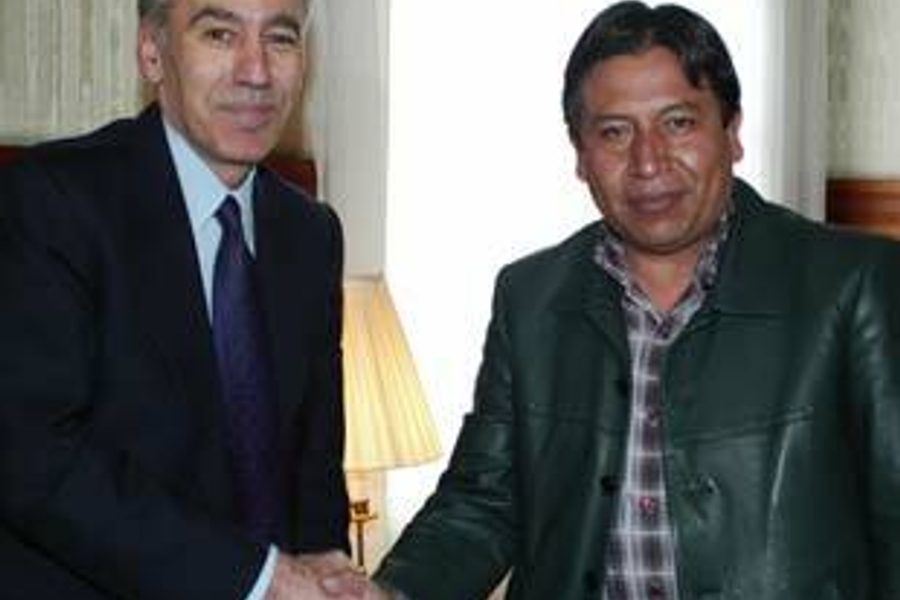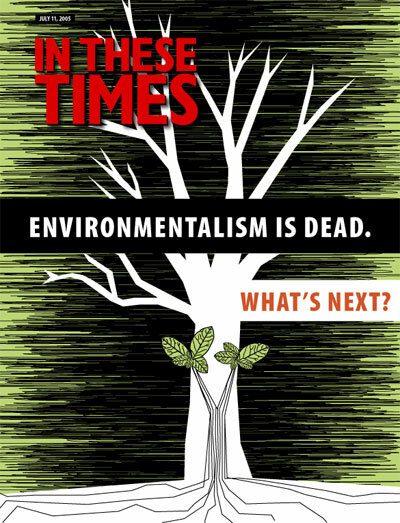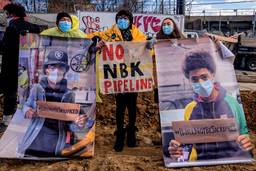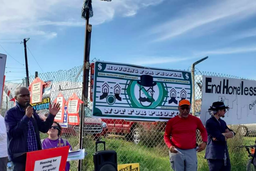Bolivian legislators abandoned a besieged La Paz on June 9 to convene in Sucre, nearly 500 miles to the southeast, in order to select a new president. But demonstrators had other ideas. Blockades were lifted so that truckloads of protesters could race to Sucre to prevent parliament from naming right-wing Senate leader Hormando Vaca Diez as the successor to the ousted Carlos Mesa. Mayors of La Paz and El Alto announced hunger strikes to oppose Vaca Diez, who was supported by only 16 percent of Bolivians in a recent poll.
Parliament’s morning session was cancelled as miners, coca growers and other demonstrators battled police in the streets, leading to one death, labor leader Juan Coro, who was shot in the chest by police. According to news reports, several legislators urged the cancellation of the session so that they could fly out of Sucre before demonstrators took over the airport. They didn’t move quickly enough. In protest of Vaca Diez, airport workers went on strike and the airport was shut down. Now stuck in Sucre, parliament met near midnight and gave in. Vaca Diez – yes, his name is “Ten Cow” – resigned his constitutional right to ascend to the throne, as did the next in line, Marlo Cossio. At 11:47 p.m., the man whom protesters had been demanding for president, Supreme Court leader Eduardo Rodriguez, was sworn in.
Since then, blockades have been lifted along with tensions, and Rodriguez has vowed to call new elections for president and congress within six months. Bolivia has been locked in an ideological stalemate for several years now, but the wind seems to be blowing leftward after the last several weeks. Although the crisis is simmering for now, the main thrust of the demonstrators’ demand has not yet been met.
The uprising revolved around control of Bolivia’s vast and recently discovered reserves of natural gas, valued at more than $250 billion – 10 times the nation’s annual GDP. On May 16, the Bolivian government raised taxes on foreign companies who exploit the reserves. Indigenous groups took to the streets, claiming the bill didn’t go far enough and calling for full nationalization of the industry. Evo Morales, leader of the strongest indigenous party in the nation – Movement Toward Socialism, or MAS – initially rejected calls for nationalization, asking instead for higher taxes. Caught in the middle, he has since moved to the left, endorsing nationalization but arguing that it should be done through a national constitutional assembly. A June 12 poll showed 76 percent support for nationalization.
On June 3, President Mesa capitulated to the demand of a constitutional assembly, but by that time it was clear that the demonstrators, two weeks into their stay in La Paz, were looking for more. Mesa offered his resignation, opening the door for Vaca Diez and the ensuing drama.
Jim Shultz, director of the Bolivian-based Democracy Center, reported during the crisis that a “very reliable source” told him that the United States was working behind the scenes to pave the way for Vaca Diez. Steve Pike, a State Department spokesperson, said he had no knowledge of any U.S. efforts to propel Vaca Diez, but if true, it’s fitting that the United States would meddle in the crisis. In at least two significant ways, this is a crisis of U.S. making.
The lynchpin of these demonstrations – and the ones in October 2003 that drove Mesa’s predecessor, Gonzalo Sanchez de Lozada, from office – is MAS and Evo Morales. Though the left could surely raise hell in La Paz and El Alto without Morales, with him the coalition becomes a national force. The bad news for the United States, though, is that Evo Morales represents blowback from the U.S. war on drugs.
Morales’ base and the roots of his strength lie in the Chapare region, which at its heyday grew between one half and two thirds of the world’s coca – the plant needed to make cocaine – that has been the principal focus of U.S.-backed and -funded eradication efforts. Generally speaking, eradication is not a peaceful affair.
On May 8, 2003, U.S.-funded joint task force agents raided Hilaria Perez’s coca farm. Perez – who lives with her husband and four children in a two room, dirt floor shack with splintering wood walls – was shot in the back as she ran to her field to protect her only source of income. “It hurts to lift heavy things,” she says, baring the jagged scar on her chest where the bullet exited. “I can’t work in the field anymore.” Godofredo Reinicke, the former head of the government’s human rights taskforce, confirmed her story, adding that the soldier was never identified. Perez and her husband are MAS party members.
Felipe Caceres, a former two-term mayor of Villa Tunari and a right-hand man of Morales, says that U.S.-funded repression led to a backlash among the cocaleros, which MAS was able to channel into the tightly organized movement that exists today. Over papaya juice in his air conditioned home, a priest in Villa 14 de Septiembre agreed with Caceres’ assessment. “The strength of the party comes from the unity that has come from the coca issue,” he says.
The United States created the monster demonstrations by giving rise to their primary demand. At U.S. urging, Bolivia sold off majority control of its oil and gas company to Enron and Shell in December 1996 for $263.5 million, well less than 1 percent of what the gas alone is worth today. A decade later, indigenous Bolivians have the receipt and are demanding a refund.
With close to 80 percent backing, nationalization of the gas industry doesn’t seem as radical an idea as it did even a month ago. The Washington Consensus has left a bad taste in Bolivia’s mouth, and the nation may be ready for an alternative.
The next 6 months will be crucial for Bolivia. Will the left rally behind Evo Morales and bring about the rise of another left wing leader in a rapidly unifying South America? Or will factionalism allow another Harvard-trained economist to lead South America’s poorest nation?
Stay tuned. You can be sure that Shell is.







